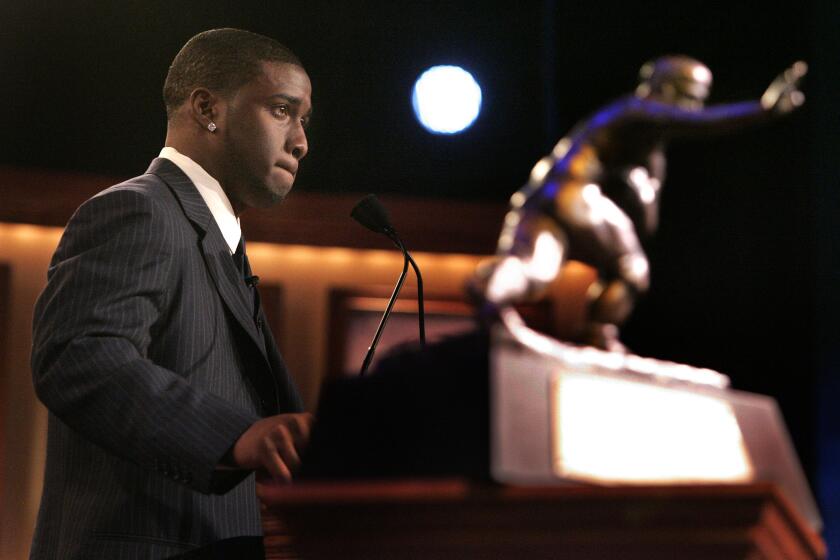AEG wants no part of Coliseum Commission
AEG’s Tim Leiweke, the point man for a new downtown football stadium, said the Coliseum would be in play as a temporary home for a relocated NFL team only if it was USC — and not the Coliseum Commission — that cut the deal.
“There is no way the Coliseum works for us in its current situation, whether a team is playing there for one year or four years,” Leiweke told The Times. “There is no way economically we are the engine that drives a renovation.
“Nothing’s going to happen at the Coliseum unless it happens through USC. That’s just the reality of the situation.”
Leiweke also responded sharply to a recent comment by San Diego Chargers attorney Mark Fabiani that it would require a “miracle” for AEG to break ground on a stadium project by next year. The Chargers have been looking for a stadium solution in the San Diego area for almost a decade and are a top relocation candidate.
“I think the problem with the Chargers is, [Fabiani] can sit here and talk about all the things we need to go through,” Leiweke said, “but the last time I checked, they’ve been doing it for 10 years and they’re nowhere.
“And the difference between us and them is we’ve got a guy willing to write a check for a billion. They’ve got zero financing, zero entitlements, zero design, zero deal with the city, and zero property that ultimately is not contaminated. Good luck.”
He added that the Chargers “are not the only belle at the ball.”
“I’m not going to say anything negative about their project, and my advice to Mark is he ought to stay focused on his, and let us stay focused on our little miracle up here.”
Fabiani, who made the miracle remark to ESPN.com, said the Chargers are currently focused on doing a stadium deal in San Diego and that “our fans deserve to know the barriers that are in the way of all of these projects — including our project here in San Diego. All of these stadium projects, from San Diego, to Los Angeles, to Santa Clara, to Oakland, they have a long way to go.”
As for Leiweke’s comments about the “zero” progress in San Diego, Fabiani said: “We respectfully disagree with Tim’s view of our situation.
“San Diego has the one thing that no one else in this process has — an NFL franchise — and no stadium project anywhere can succeed without a team.”
This could all be part of the negotiations dance. AEG Chairman Philip Anschutz and Chargers President Dean Spanos are far apart on how much of the team would be sold and for what price.
“We haven’t talked to the Chargers in a while,” Leiweke said.
Developer Ed Roski has a competing stadium proposal in the City of Industry, where he controls 600 acres entitled for a venue.
Both proposals would rely on either the Coliseum or Rose Bowl being used as a temporary home for a relocated team.
Meanwhile, a fight is brewing at the Coliseum between the university and the commission, the venue’s landlord. Under the terms of the lease signed in 2008, the commission would complete about $50 million in stadium improvements over a 10-year period, upgrades that were supposed to be financed by the sale of naming rights.
There has been no major naming-rights deal, and the commission has yet to provide USC with a business plan that was due in June 2010 to explain how it intends to pay for the improvements. That deadline has been extended twice — USC said it will agree to no more extensions — and the new due date is Sept. 30.
Under the terms of the lease, if the commission cannot pay for the improvements, the university can fund them itself and recover that money by withholding rent. The commission, then, would not be able to make its rent payments to the state, setting the stage for the school to take control of the stadium by cutting a deal directly with the state.
While stressing that he is not intending to pick a fight with the commission, Leiweke said the only way AEG would negotiate to put a team in the Coliseum on a temporary basis — and he believes it would be AEG and the team’s majority owner jointly making that decision — is if USC were calling the shots on the other end. Part of the agreement with the city calls for AEG to make its best effort to use the Coliseum, rather than housing the team in Pasadena.
“There is no question in my mind that if USC has the ability to run that building, we’d be able to make a deal with USC,” he said. “I don’t think there’s a conflict between what we would need for a temporary home and what USC wants for their permanent home. I think it’s a very viable option, but a viable option where the path must go through USC.”
Bernard Parks, a city councilman and longtime Coliseum commissioner , said AEG cannot force the commission to the sideline just because it prefers to deal with USC.
“They can’t ignore the Coliseum Commission,” Parks said. “The structure of running the Coliseum and Expo Park is in place with three legislative bodies set in place as a joint powers, clearly by state law, agreed on by the county and the city. They can’t bypass that. … They can’t ignore the people who own the facility.
“You can’t get an invitation to a party and then say, ‘Oh, and I want to bring my cousin.’ ”
There’s no small irony in AEG taking a position in a fight that could ultimately render that nine-member panel irrelevant. In 2002, it was the Coliseum Commission that nudged AEG off the idea of an earlier downtown NFL proposal, one that many people believe Anschutz wasn’t committed to anyway.
“The reality of the situation is USC is the key to solving that problem,” Leiweke said. “There will be people not happy with us for making that comment, but it’s true.”
More to Read
Get our high school sports newsletter
Prep Rally is devoted to the SoCal high school sports experience, bringing you scores, stories and a behind-the-scenes look at what makes prep sports so popular.
You may occasionally receive promotional content from the Los Angeles Times.







